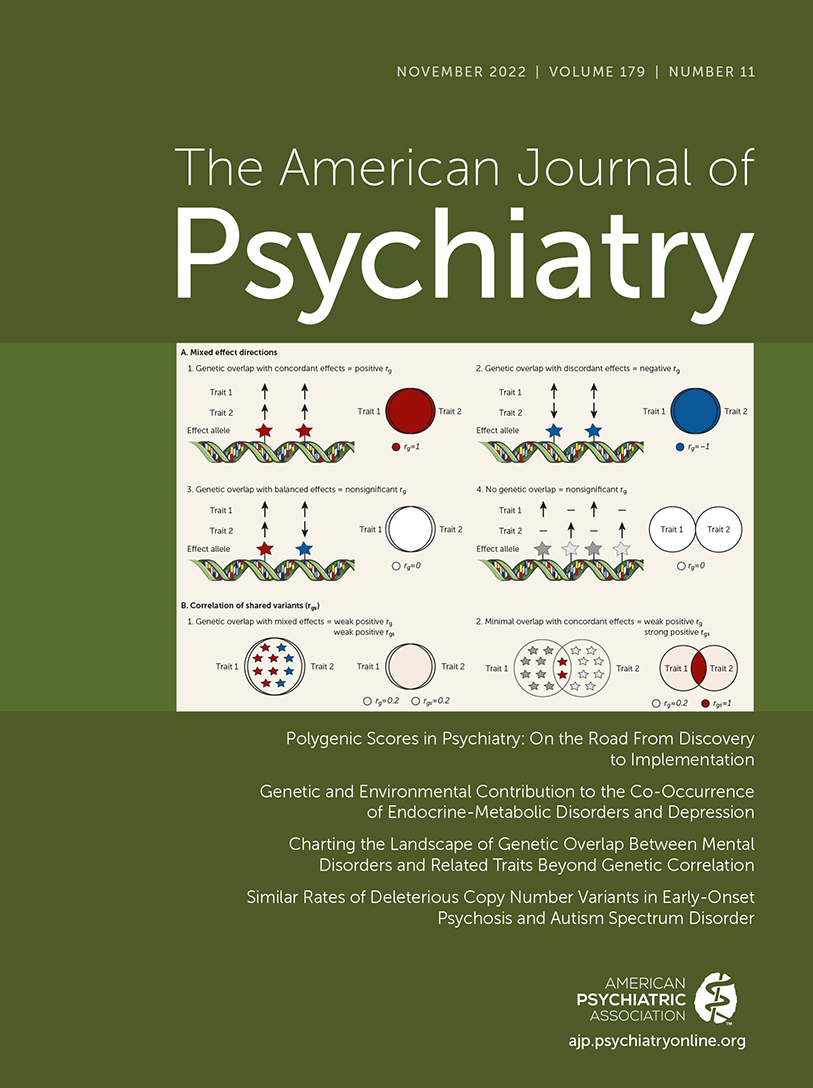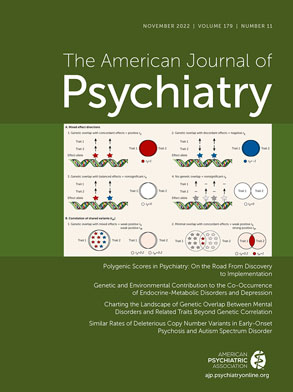Could (almost) everything we know about the common genetic effects shared between psychiatric disorders be wrong? In this issue of the
Journal, Hindley et al. (
1) present new analyses on the degree to which a range of psychiatric disorders share common genetic variation. The authors use a method that can quantify the number of putatively “causal” variants unique to and shared across each condition. Importantly, this new study distinguishes itself from past work by employing a method that reveals the direction of effect of shared genetic variants across conditions. Thus, they can quantify genetic variation that is involved in two different disorders, but also find out the proportion of effects that act in the same direction for both conditions (i.e., increasing likelihood for both conditions) or in opposite directions (i.e., increasing likelihood for one condition and reducing likelihood for the second condition). The study offers some completely new results, changing what we know about genetic relationships between psychiatric disorders, and thus it may represent a major leap forward in this area.
But first, let’s refresh our minds on why we study genetic causes of co-occurrence of psychiatric disorders. It would be useful to understand why psychiatric disorders often co-occur, so that we can both advise families and patients better about why this happens and develop tailored support and treatment. There are a range of reasons why two disorders can co-occur (
2), one of which is correlated underlying risk factors, which is the focus of Hindley and colleagues’ work. (A note on wording: for brevity, “psychiatric disorders” is used here to refer to both psychiatric and neurodevelopmental conditions, although it should be noted that the latter are a different DSM-5 category.)
In terms of testing whether two heritable disorders share some of the same genetic influences, for many decades twin studies have been able to do this. For example, early work by one of us (A.R.) showed for the first time that autism and ADHD, both when measured as traits and as likely diagnoses, showed high genetic correlations (
3). This helped to explain why autism and ADHD so often co-occur. For those unfamiliar with the term, a “genetic correlation” acts like a normal correlation in that it can vary between −1 and 1, but it indicates the degree of shared genetic influences between two phenotypes and is independent of the size of the heritability of each phenotype in that population.
Genetic correlations can now be estimated from DNA using the results (usually called “summary statistics”) from genome-wide association studies, and a statistical method called linkage disequilibrium (LD) score regression is commonly applied (
4). Bivariate LD score regression compares genetic effect sizes for each condition, while accounting for LD, looking across all genetic variants (referred to as an infinitesimal model). This has been the status quo for how to estimate degree of overlap in common genetic variation between two disorders. A prevailing issue with this genetic correlation, however, is that if the same genetic loci are involved across two disorders but there is a mixture of effects in the same direction and the opposite direction, this cannot be differentiated from a lack of genetic overlap. Furthermore, biologically, we might be interested to know if the same genetic locus was involved across two conditions even if the locus had opposite direction of effects.
With that background in mind, we turn our attention to Hindley and colleagues’ new results. Hindley et al. apply a method called MiXeR (
5), which quantifies the number and proportion of putatively “causal” genetic variants that are unique to and shared across conditions, and then estimates the genetic correlation specifically for the shared loci (i.e., leaving out the condition-specific). Its name stems from the fact that it relies on a mixture model (rather than an infinitesimal model) and assumes that there is a mixture of causal and noncausal variants.
A specific example helps to demonstrate these points. For ADHD and schizophrenia, the “normal” genome-wide genetic correlation (akin to LD score regression) is 0.19, which would lead us to think that there is only modest overlap in common genetic influences between ADHD and schizophrenia. However, Hindley and colleagues’ work indicates that the majority of genetic variants affecting either condition also affect the other, but the direction of effect varies across condition. The mix of same-direction effects and opposite-direction effects drives down the magnitude of the overall genome-wide genetic correlation. In other words, some of the same loci are involved in ADHD and schizophrenia, but there are mixed effect directions. This discovery, that mostly the same loci involved in ADHD are also involved in schizophrenia (although note that schizophrenia also shows further variants not involved with ADHD), is hidden in the “normal” low genome-wide genetic correlation of 0.19.
Taking a step back, why is this important to know? First, conceptually, the results suggest that psychiatric disorders are caused by largely the same set of genetic loci, but it is the effect size and the direction of effect of each locus that influence which specific disorder an individual develops. Hindley and colleagues’ results enable us to hypothesize how, at the neurobiological level, specific psychiatric disorders manifest. An understanding of the neurobiology of co-occurring disorders will influence personalized support and intervention and should help with differential diagnoses. The authors suggest that their results could inform the creation of a “personalized, biologically informed diagnostic system.”
Picking up on the point of personalized systems within psychiatry, one characteristic that can vary widely between individuals with psychiatric disorders, and which may influence the causes of co-occurring conditions, is age at onset. Does age at onset affect the genetic correlation between two co-occurring psychiatric conditions? A recent study (
6) found that the genetic correlation between childhood-onset ADHD and autism is higher than the genetic correlation between late-diagnosed ADHD and autism.
Furthermore, moving away from thinking solely about genetic influence, all psychiatric disorders are influenced by a combination of genetic and environmental influences. In another recent study (
7), the heritability of psychotic experiences was found to be moderated by extent of environmental adversity. This gene-environment interaction effect was found after controlling for gene-environment correlation (heritable effects on the environmental adversities). It is not unrealistic to suggest that genetic correlations between co-occurring psychiatric disorders are likely also to vary as a function of covarying risk environments.
If we bring these different strands of new work together—age-at-onset differences in genetic correlations, environmental moderation of genetic effects, and Hindley and colleagues’ new findings described above—an exciting view of a future emerges. That is, we could understand the common genetic effects shared between psychiatric disorders in a much more specific way. A genetic correlation between two psychiatric disorders could be estimated in a multidimensional space where we consider the key aspects of the disorder characteristics, such as age at onset; the environmental context, such as presence or absence of adversity; and the location and direction of effect of genetic variants.
Before we conclude, we raise some cautionary points. Ultimately, the method applied by Hindley et al. is a statistical model of the data, and as with all statistical models, it comes with assumptions and limitations. Hindley et al. describe their method and note, for example, that MiXeR does not include alleles with minor allele frequencies under 5% and assumes that effect sizes are independent of allele frequency. They note too that at present their work is limited to European samples and that future work must drive forward equivalent approaches for all ancestral groups.
MiXeR is a relatively new method and is still being developed further. In addition, there are other new approaches that can help us further understand psychiatric co-occurrence at a genetic level. For example, polygenic scores between autism and cognitive performance have been generated separately for loci with same versus opposite direction of effects (
8). LAVA (
9) can estimate the genetic correlation between two phenotypes within specific loci, referred to as
local genetic correlations, and is another means of exploring same versus opposite direction of genetic effects (see also ρ-HESS) (
10). A final consideration is that to move from one of the “loci” mentioned in Hindley and colleagues’ work to the resolution needed for an animal model or a drug target, several steps would be needed to fine-map the location to find the specific biological variants involved. For example, LAVA could be used to detect specific loci with same/opposite genetic effects, co-localization could be used to determine whether the overlapping signal is driven by the same causal variant(s). Following this, single-nucleotide polymorphism fine-mapping could be used to identify the exact causal variants, and integration of functional genomic annotations could infer how these variants alter gene function and in which spatiotemporal context.
Our hope is that these advances will lead to palpable translational benefits for patients. Alongside the one-size-fits-all genetic correlation, it’s time to familiarize ourselves with the possibilities of locus-specific, developmentally specific, environmentally moderated, variant-driven genetic correlations.
Acknowledgments
The authors thank Robert Plomin for comments on an earlier version of this editorial.

